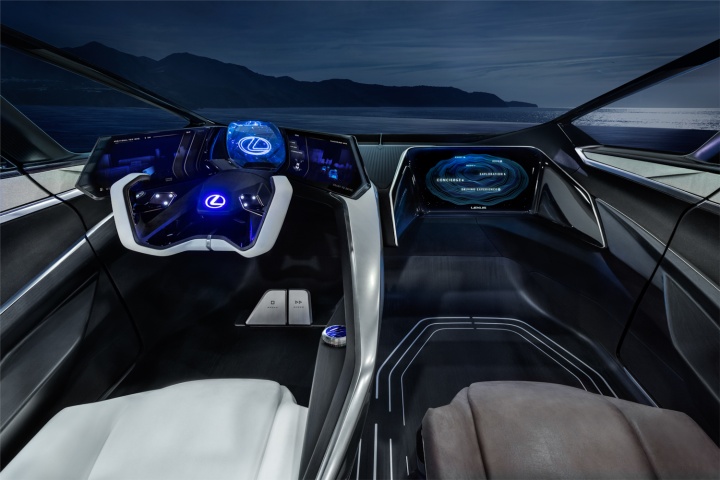Lexus has brought a dramatic all-electric concept car, called the LF-30, to the Tokyo motor show.
An electric Lexus for 2030
The LF-30 is a wedge-shaped, crossover-ish four-seater with a pair of striking gullwing doors that open out to reveal almost the entire cabin at once. It's not a direct preview of the brand's first electric production car (which is scheduled to be unveiled next month) but is a look ahead to around ten years into the future. An all-electric RX450 from 2030, if you like.
The LF-30 actually uses four individual in-wheel motors for its power. This cuts down on frictional losses in the powertrain, and also allows each wheel to be fed a precise power output to maximise both agility and safety. The shape of the LF-30 is meant to create a visual flow of bodywork out to each individual wheel, to emphasise the way the power is delivered. Lexus calls this 'Advanced Posture Control technology' and it's expected to form a bedrock of future Lexus electric vehicles.
500km range, 700Nm torque
The steering is steer-by-wire (there's no physical connection to the wheels), and the steering wheel can be folded out of the way for autonomous driving. The car's battery can be recharged with wireless inductive charging. Lexus says the LF-30 will have a range of 500km (WLTP), from a 110kWh battery, with a 0-100km/h time of just 3.8 seconds. The four motors combined produce 700Nm of torque.
There's even a built-in drone (because of course there is) called the 'Lexus Airporter' which is designed to be able to pluck your luggage or shopping out of the boot and deliver it to your door.
Because there's no radiator grille, the Lexus 'spindle' grille has been spread out to take over the entire front end of the car, with wing-shaped headlights at the corners. The rest of the body flows backwards from there.
The side windows use reactive glass, which can be lightened or darkened as you wish, depending on whether you want to see out, or to stop others seeing in.
'Control with one rein'
It wouldn't be a Japanese concept car without introducing us to a Japanese phrase that encompasses an entire idea in a single word. This time it's "Tazuna" which is apparently the sensation of gently controlling a horse by using just a single rein, bringing about "mutual understanding between horse and rider." Sounds a lot like Mazda's 'Jinba Ittai' to us...
Basically, it means that controls and displays have mostly been centred on the steering wheel and the heads-up display, so that a driver can keep their hands on the wheel and their eyes on the road, no matter which functions they need to use. Gesture control and augmented reality are also worked into the LF-30's systems.
The front passenger seat has been designed to mimic first-class airline seats, while the back seats have 'artificial muscle technology' to either keep people alert, or soothe them off to sleep. The Mark Levinson audio system can create individual 'acoustic spaces' for each person in the car, thanks to speakers mounted in the seat headrests.
For the ultimate in entertainment, the 'SkyGate' glass roof also doubles as a video screen, meaning you can watch movies on the roof, see navigation maps, or even project the names of the stars in the night sky.
As for the materials used, there's an emphasis on recyclable surfaces, including a Japanese burned cedar for wood trim, and fibres made from pressed, recycled metal.

























